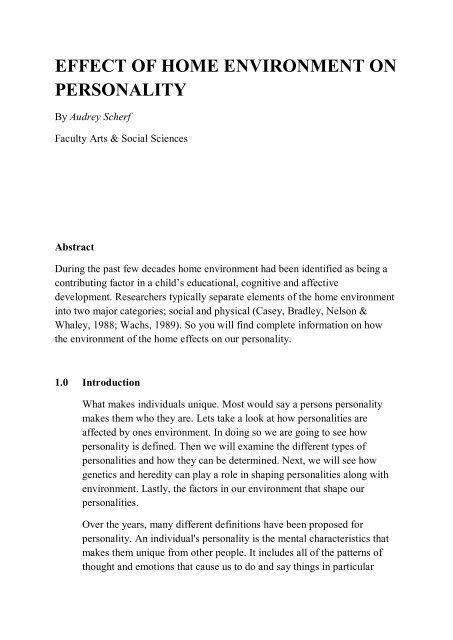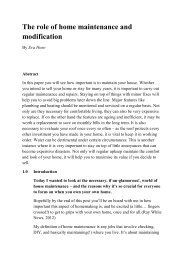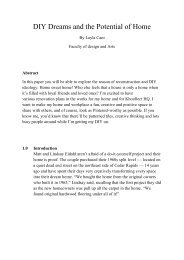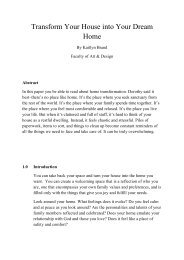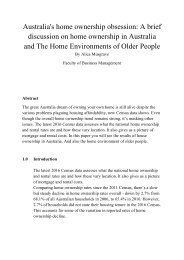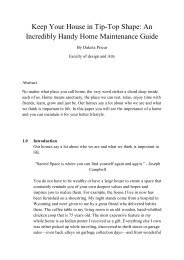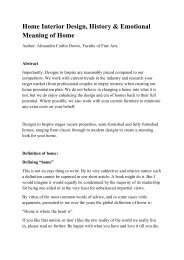EFFECT OF HOME ENVIRONMENT ON PERSONALITY
You also want an ePaper? Increase the reach of your titles
YUMPU automatically turns print PDFs into web optimized ePapers that Google loves.
<strong>EFFECT</strong> <strong>OF</strong> <strong>HOME</strong> <strong>ENVIR<strong>ON</strong>MENT</strong> <strong>ON</strong><br />
PERS<strong>ON</strong>ALITY<br />
By Audrey Scherf<br />
Faculty Arts & Social Sciences<br />
Abstract<br />
During the past few decades home environment had been identified as being a<br />
contributing factor in a child’s educational, cognitive and affective<br />
development. Researchers typically separate elements of the home environment<br />
into two major categories; social and physical (Casey, Bradley, Nelson &<br />
Whaley, 1988; Wachs, 1989). So you will find complete information on how<br />
the environment of the home effects on our personality.<br />
1.0 Introduction<br />
What makes individuals unique. Most would say a persons personality<br />
makes them who they are. Lets take a look at how personalities are<br />
affected by ones environment. In doing so we are going to see how<br />
personality is defined. Then we will examine the different types of<br />
personalities and how they can be determined. Next, we will see how<br />
genetics and heredity can play a role in shaping personalities along with<br />
environment. Lastly, the factors in our environment that shape our<br />
personalities.<br />
Over the years, many different definitions have been proposed for<br />
personality. An individual's personality is the mental characteristics that<br />
makes them unique from other people. It includes all of the patterns of<br />
thought and emotions that cause us to do and say things in particular
ways. Personality concerns the most important, most noticeable parts of<br />
an individual's psychological life. Personality can be defined as a<br />
dynamic and organized set of characteristics possessed by a person that<br />
uniquely influences his or her cognitions, motivations, and behaviors in<br />
various situations. There are some fundamental characteristics of<br />
personality.<br />
Figure 1<br />
There is generally a recognizable order and regularity to behaviors.<br />
People act in the same ways or similar ways in a variety of situations.<br />
Personality is psychological, but research suggests that it is also<br />
influenced by biological processes and needs. Personality does not just<br />
influence how we move and respond in our environment, it also causes us<br />
to act in certain ways. Personality is displayed in more than just behavior.<br />
It can also be seen in our thoughts, feelings, close relationships and other<br />
social interactions.<br />
Most people would agree that personality is unique to an individual<br />
person. With so many people in the world, it would not be far fetched to<br />
believe that there are different types of personalities. Putting these<br />
personalities into specific category types would help people determine<br />
what personality type they are.
This was done in the early 1950's, by David Riesman. He proposed that<br />
there are three common types of modal personality that occur around the<br />
world. He called them tradition oriented, inner-directed, and other<br />
directed personalities. The tradition-oriented personality is one that places<br />
a strong emphasis on doing things the same way that they have always<br />
been done. Individuals with this sort of personality are less likely to try<br />
new things and to seek new experiences. Those who have inner-directed<br />
personalities are guilt oriented. Their behavior is strongly controlled by<br />
their conscience. As a result, there is little need for police to make sure<br />
that they obey the law. These individuals monitor themselves. If they<br />
break the law, they are likely to turn themselves in for punishment. In<br />
contrast, people with other-directed personalities have ambiguous<br />
feelings about right and wrong. When they deviate from a societal norm,<br />
they usually don't feel guilty. However, if they are caught in the act or<br />
exposed publicly, they are likely to feel shame.<br />
Figure 2<br />
Those that follow Riesman's concept of three modal personalities suggest<br />
that the tradition-oriented personality is most common in small-scale<br />
societies and in some sub-cultures of large-scale ones. Inner-directed<br />
personalities are said to be more common in some large-scale societies,<br />
especially ones that are culturally homogenous. In contrast, the otherdirected<br />
personality is likely to be found in culturally diverse large-scale
societies. in which there is not a uniformity. Some believe that one person<br />
can have traits of more than one of the personality types.<br />
Today there are a few different test that can be done to determine what<br />
type of personality an individual may have. This may be done through the<br />
Minnesota Multiphasic Personality Inventory, Rorschach Inkblot test, or<br />
the Thematic Apseries of answers to a questionnaire that asks people to<br />
indicate the extent to which sets of statements or adjectives accurately<br />
describe their own behavior.<br />
There is an argument of what shapes the personality of a person. Is it the<br />
genes that shapes a persons personality? Are personalities formed by<br />
hereditary traits? Is the environment we live in the primary factor that<br />
gives us are personality? Ruth Benedict beginning in the 1920's believed<br />
that personality was almost entirely learned by our environment. Benedict<br />
said that our cultural personality patterns are assumed to be "natural" by<br />
us and other personality patterns are viewed as being "unnatural" and<br />
deviant. She said that such feelings are characteristic of all people in all<br />
cultures because we are ethnocentric.<br />
Figure 3<br />
Benedict compared the typical personalities of the 19th century North<br />
American Plains Indians with those of the farming Pueblo Indians of the<br />
Southwest. She said that the bison hunting Plains Indians had<br />
personalities that could be typified as being aggressive, prone to violence,
and seeking extreme emotional states. In contrast, she said that the typical<br />
Pueblo Indian was just the opposite, peaceful, non-aggressive, and sober<br />
in personality.<br />
Some say that hereditary factors passed by our parents and ancestors to us<br />
are the main factor to ones personality. The individual’s talent and<br />
some other traits are just few examples of these traits. Some hereditary<br />
factors that contribute to personality development do so as a result of<br />
interactions with the particular social environment in which people live.<br />
For instance, your genetically inherited physical and mental capabilities<br />
have an impact on how others see you, and how you see yourself. If you<br />
have poor motor skills that prevent you from throwing a ball straight and<br />
if you regularly get bad grades in school, you will very likely be labeled<br />
by your teachers, friends, and relatives as someone who is inadequate or a<br />
failure to some degree. This can become a self-fulfilling prophesy as you<br />
increasingly perceive yourself in this way and become more pessimistic<br />
about your capabilities and your future. Likewise, your health and<br />
physical appearance are likely to be very important in your personality<br />
development. You may be frail or robust. You may have a learning<br />
disability. You may be slender in a culture that considers obesity<br />
attractive or vice versa. These largely hereditary factors are likely to<br />
cause you to feel that you are nice-looking, ugly, or just adequate.<br />
Likewise, skin color, gender, and sexual orientation are likely to have a<br />
major impact on how you perceive yourself. Whether you are accepted by<br />
others as being normal or abnormal can lead you to think and act in a<br />
socially acceptable or even deviant way.(EssaysUk, 2013)<br />
2.0 Literature Review<br />
2.1 What Impact Does the Environment Have on Us?<br />
Since the earliest times, humans have needed to be sensitive to<br />
their surroundings to survive, which means that we have an innate<br />
awareness of our environment and seek out environments with<br />
certain qualities.<br />
First of all, humans have a strong need for safety and security and<br />
look for those attributes in their environment. We also look<br />
for physical comfort, such as an environment with the right<br />
temperature. In addition, we seek an environment that
is psychologically comfortable: for example, environments that are<br />
familiar, but offer the right amount of stimulus.<br />
Figure 4<br />
Retailers and the hospitality industry know this very well and try to<br />
provide an atmosphere that creates a positive customer experience<br />
and offers three important attributes: comfort, safety, and<br />
entertainment. These attributes are equally important in healthcare<br />
as well. Below are just a few examples of how the environment can<br />
impact you:<br />
1. The environment can facilitate or discourage interactions<br />
among people (and the subsequent benefits of social<br />
support). For example, an inviting space with comfortable<br />
chairs and privacy can encourage a family to stay and visit<br />
with a patient.<br />
2. The environment can influence peoples' behavior and<br />
motivation to act. For example, a dingy corridor filled with<br />
extra hospital equipment will invite staff to leave another<br />
item in the hall, whereas a clean corridor and adequate<br />
storage will encourage staff to take the time to put the item<br />
away.<br />
3. The environment can influence mood. For example, the<br />
results of several research studies reveal that rooms with<br />
bright light, both natural and artificial, can improve health
outcomes such as depression, agitation, and sleep.(Mary Jo<br />
Kreitzer, RN, 2014)<br />
2.2 What about stress at home?<br />
It’s no secret that our environments influence the way we think,<br />
feel and act. Most people desire good health and for most people,<br />
their home is the environment they are most often surrounded by.<br />
Everyone deserves to a live happy, healthy life and can start by<br />
creating a home environment optimal for health.<br />
Would you like to attain happiness, contentedness or joy in your<br />
daily life? Are you trying to eat healthier or exercise more? Both<br />
mental and physical health are important to your overall well-being<br />
and both are easier to achieve when you reduce stress and<br />
encourage better eating habits at home. Taking these steps to make<br />
changes in your home will create an optimal environment for<br />
making healthy choices that you can carry into the other areas of<br />
your life.<br />
2.3 Reduce Stress and Fatigue<br />
Stress reduction is the first step toward living a<br />
healthy life, because stress is a large determinant of good health.<br />
Continuous or chronic stress can cause muscle tension, headaches<br />
and migraines, heart problems, adrenal fatigue, nausea, overeating<br />
and is overall draining for your energy levels.<br />
Once all of the controllable stressors are removed from your life,<br />
you can more easily take positive proactive steps toward health.<br />
The first step to reducing stress in your life is to reduce the clutter<br />
in your home! Scientists at Princetonfound that clutter reduces your<br />
ability to focus as well as your ability to process information.<br />
Although deep-cleaning your possessions is a time-consuming first<br />
step toward health, it will pay off in the long run. Take anywhere<br />
between half of a day and a day, depending on how much clutter<br />
you have, to go through your belongings. Sort the items you do not<br />
use into a donate or discard pile. Create a ―home‖ for everything<br />
you are keeping so that future cleaning will be easier and less<br />
stressful.
Figure 5<br />
Another method to relieve stress is bringing some of Mother<br />
Nature’s magic into your home. Several studieshave shown that<br />
exposure to nature improves mood and reduces stress. Although<br />
looking at a painting or photograph of plant life isn’t as beneficial<br />
as a walk through the woods, art that imitates nature still has<br />
positive effects on the brain. If you would rather have actual plant<br />
life in your home instead of art, there are plenty of plants that do<br />
not need sunlight or a lot of water. There are quite a few plants that<br />
purify the air and require almost zero maintenance, such as spider<br />
plants and garden mums.(Redfin Guest Blogger, 2016)<br />
3.0 Different Approaches to Personality<br />
3.1 The psychoanalytic approach<br />
Ruch(1984) explains that the psychoanalytic theory of<br />
Freud is simultaneously a theory of personality, motivation,<br />
development and mental illness (1933,1935,1938). Main idea<br />
behind the psychoanalytic scheme is the concept that only a small<br />
part of human mental activity is illustrated by conscious thought. A<br />
relatively large part of mental activity occurs at the preconscious<br />
and unconscious levels. Processes that are not in consciousness at a<br />
given time are preconscious activities, but that can become<br />
conscious as needed. However, unconscious activities are more
important; these are largely, storage of instinctive urges.<br />
Unconscious activities can influence behavior, but these activities<br />
cannot directly enter consciousness. Freud’s perception of how<br />
these three levels interact in an individual’s personality is based on<br />
three inferred personality structures: id, ego and super ego.<br />
Unconscious forces, which are accumulation of the sex and<br />
aggression instincts are represented by id. Although id’s mental<br />
workings are not available for conscious inspection but its impulses<br />
can be sensed. Conscious representative of rational thought is ego.<br />
Newly born baby reflects only id forces; and the ego develops<br />
gradually through the child’s interaction with the external world.<br />
Along with ego, superego is also developed by the child’s<br />
experience. Superego represents the internalization of the society’s<br />
and parent’s prohibitions. According to Freud, behavior is<br />
determined by the interaction of these three elements of the adult<br />
personality.<br />
3.2 The Behavioural Approach<br />
Before Skinner’s behaviorism and Bandura’s social learning theory<br />
a brief description of Dollard and Miller’s behavioral approach is<br />
being described. Ruch (1984) explains that John Dollard and Neal<br />
Miller developed their theory of personality in the late 1940s.The<br />
theory they developed was based on four concepts: drive, cue,<br />
response, and reinforcement. Freud’s instincts, as represented in<br />
the id, became for Dollard and Miller primary drives. These, in<br />
turn, were the basis for other learned drives (Miller, 1951). The<br />
combination of primary and learned drives provided the energy or<br />
motivation for behavior, and cues determined when, where, and<br />
which behavior would ensue. Any distinctive stimulus, in any<br />
sensory mode, could become a cue for some response, based on the<br />
learning history of the organism. Once the response had occurred,<br />
it could be followed by a reinforcement. If so, the response became<br />
more probable in the presence of the cues.<br />
Although not the only version of behaviorism, Skinner’s approach<br />
is one of the best known and most controversial (Rachlin, 1976).<br />
All behaviorists emphasize overt, measurable behavior, but Skinner<br />
has insisted on limiting analysis to it. Internal activity, whether
phrased in nervous-system terms or mental terms, is not an<br />
appropriate level of analysis, he feels. In this, Skinner is more<br />
extreme than many behaviorists, who are more willing to consider,<br />
for example, the possibility of thoughts as covert behavior<br />
(Meichenbaum,1977). Skinner’s view is often termed radical<br />
behaviorism because of his insistence on referring to<br />
environmental events in considering any behavior. His is virtually<br />
the only approach to personality to forgo all inferred constructs and<br />
to rely only on observed behavior and contingencies of<br />
reinforcement. Skinner refuses to consider internal activities partly<br />
because they are so difficult to measure. But he also believes that<br />
internal events such as thoughts or emotions are results of external<br />
events, not causes of them.<br />
3.3 The Humanistic Approach<br />
The humanistic approach is usually attributed to the independent<br />
approaches of two theorists, Abraham Maslow and Carl Rogers.<br />
Both emphasize concepts of the self and selfdevelopment, but they<br />
differ somewhat in how these concepts are defined and used. Ruch<br />
(1984) explains that Maslow’s views, like Freud’s were strongly<br />
influenced by his beliefs about human motivation, but his view of<br />
motivation differed radically from Freud’s.<br />
Instead of powerful,,innate, negative forces that must be kept in<br />
check, Maslow saw weak, innate, positive tendencies that must be<br />
nurtured (Maslow, 1968, 1970, 1971). Survival motives are the<br />
most powerful and most immediate motives. Maslow proposed his<br />
well-known hierarchy of needs to suggest how more exclusively<br />
human needs might appear after more basic needs were satisfied.<br />
According to Maslow, all of the needs in the hierarchy are innate to<br />
humans, but those higher in the hierarchy are weaker; they only<br />
direct action when all earlier needs have been satisfied. Roggers’s<br />
view is concerned with the development of self, but he approaches<br />
the concept of self differently than Maslow did (Suls, 1982).<br />
Roger’s personality theory is a person-centered theory in several<br />
ways (Holdstock & Rogers, 1977). First, it emphasizes a<br />
phenomenological approach, noting that each person’s experienced<br />
world is unique, built up in part from that person’s experiences.
Roger’s view is also person-centered in emphasizing selfactualization,<br />
though he defines it somewhat differently than<br />
Maslow did.(Parveen, 2007)<br />
4.0 The Trait Approach to Personality study<br />
If someone asked you to describe a close friend's personality, what kind<br />
of things would you say? A few things that might come to mind are<br />
descriptive terms, such as "outgoing," "kind" and "even-tempered." All of<br />
these represent traits. What exactly does this the word "trait" mean?<br />
Figure 6<br />
A trait can be thought of as a relatively stable characteristic that causes<br />
individuals to behave in certain ways.<br />
The trait approach to personality is one of the major theoretical areas in<br />
the study of personality. The trait theory suggests that individual<br />
personalities are composed of these broad dispositions.<br />
Unlike many other theories of personality, such<br />
as psychoanalytic or humanistic theories, the trait approach to personality<br />
is focused on differences between individuals. The combination and<br />
interaction of various traits form a personality that is unique to each<br />
individual. Trait theory is focused on identifying and measuring these<br />
individual personality characteristics.
4.1 Gordon Allport’s Trait Theory<br />
In 1936, psychologist Gordon Allport found that one Englishlanguage<br />
dictionary alone contained more than 4,000 words<br />
describing different personality traits. He categorized these traits<br />
into three levels:<br />
Cardinal Traits: These are traits that dominate an<br />
individual’s whole life, often to the point that the person<br />
becomes known specifically for these traits.<br />
People with such personalities can become so well-known<br />
for these traits that their names are often synonymous with<br />
these qualities. Consider the origin and meaning of the<br />
following descriptive terms: Machiavellian, narcissistic, Don<br />
Juan, Christ-like, etc.<br />
Allport suggested that cardinal traits are rare and tend to<br />
develop later in life.<br />
Central Traits: These are the general characteristics that<br />
form the basic foundations of personality. These central<br />
traits, while not as dominating as cardinal traits are the major<br />
characteristics you might use to describe another person.<br />
Terms such as "intelligent," "honest," "shy," and "anxious"<br />
are considered central traits.<br />
Secondary Traits: These are the traits that are sometimes<br />
related to attitudes or preferences. They often appear only in<br />
certain situations or under specific circumstances. Some<br />
examples would be getting anxious when speaking to a<br />
group or impatient while waiting in line.(Kendra Cherry,<br />
2018)
5.0 5 big Personality Traits<br />
Scientists say that our personality can be deconstructed into 5 basic traits<br />
and here’s what the test measures, and a bit about what your score on<br />
each trait might say about you:<br />
5.1 Openness to experience<br />
Figure 7<br />
A high score means you’re:<br />
Original<br />
Imaginative<br />
Daring<br />
You have broad interests<br />
You generally prefer variety over fixed routines<br />
One review of studies found that, in business settings, openness is a<br />
strong predictor of who will become and succeed as a leader.
Another study found that you can tell how open someone is based<br />
on their selfie — specifically based on whether they display<br />
positive emotion.<br />
5.2 Conscientiousness<br />
A high score means you’re:<br />
Hardworking<br />
Ambitious<br />
Energetic<br />
Persevering<br />
You like planning things in advance<br />
Psychologists say conscientiousness is the best predictor of both<br />
personal and professional success. It’s also the strongest predictor<br />
of leadership in different contexts, including business, government,<br />
and school.<br />
5.3 Extroversion<br />
This trait is sometimes called ―surgency.‖ A high score means<br />
you’re:<br />
sociable<br />
fun-loving<br />
affectionate<br />
friendly<br />
talkative<br />
you derive energy from social activity<br />
Extroversion is another strong predictor of who will become a<br />
leader — though psychologists are increasingly discovering<br />
that introverts can do just as well in leadership roles.<br />
5.4 Agreeableness<br />
A high score means you’re:<br />
Sympathetic<br />
Kind<br />
Affectionate
You’re likely to engage in pro-social behaviour and<br />
volunteerism<br />
Research suggests that agreeable people tend to be happier, possibly<br />
because they try to avoid negative experiences. On the other<br />
hand, disagreeable people may be more likely to succeed at<br />
work because they’re better at getting their ideas heard.<br />
Interestingly, one study found that people who have a looser gait tend<br />
to be more agreeable (and less conscientious).<br />
5.5 Neuroticism<br />
A high score means:<br />
you worry a lot<br />
you’re insecure<br />
self-conscious<br />
temperamental<br />
That same selfie study mentioned above found that neurotic people<br />
are more likely to make a duck face. Go figure.<br />
As a reminder, you can take either version of the personality test<br />
here.(SHANA LEBOWITZ, 2016)<br />
6.0 A Psychology behind Cleanliness<br />
There’s a recent trend sweeping (pun intended) the internet: organization<br />
porn.<br />
Organization porn, like food porn, has nothing to do with pornography and<br />
everything to do with appealing, well-curetted photographs of everyday<br />
items. Whereas food porn might involve a picture of, say, a saltedcaramel<br />
cupcake with a perfectly swirled dollop of chocolate frosting on<br />
top, organization porn might involve a picture of pens arranged by colour<br />
and size, or a gorgeously minimalistic living room.<br />
(BondCleaninginPerth, 2015)
6.1 The positive psychology behind organization<br />
Keeping things clean and organized is good for you, and science<br />
can prove it.<br />
A study(link is external) led by associate professor NiCole R. Keith, Ph.D.,<br />
research scientist and professor at Indiana University, found that people<br />
with clean houses are healthier than people with messy houses. Keith and<br />
her colleagues tracked the physical health of 998 African Americans<br />
between the ages of 49 and 65, a demographic known to be at an<br />
increased risk for heart disease. Participants who kept their homes clean<br />
were healthier and more active than those who didn’t. In fact, house<br />
cleanliness was even more of a predictor for physical health than<br />
neighborhood walkability.<br />
Figure 8<br />
A 2010 study published in the scientific journal Personality and Social<br />
Psychology Bulletin (link is external)used linguistic analysis software to<br />
measure the way 60 individuals discussed their homes. Women who<br />
described their living spaces as ―cluttered‖ or full of ―unfinished projects‖<br />
were more likely to be depressed and fatigued than women who described<br />
their homes as ―restful‖ and ―restorative.‖ The researchers also found that<br />
women with cluttered homes expressed higher levels of<br />
the stress hormone cortisol.
In 2011, researchers at Princeton University(link is external) found that<br />
clutter can actually make it more difficult to focus on a particular task.<br />
Specifically, they found that the visual cortex can be overwhelmed by<br />
task-irrelevant objects, making it harder to allocate attention and<br />
complete tasks efficiently.<br />
A survey(link is external) conducted by the National Sleep Foundation<br />
found that people who make their beds every morning are 19 percent<br />
more likely to report regularly getting a good night’s sleep. People who<br />
were surveyed also reported benefits from having clean sheets —<br />
specifically, 75 percent of people said they get a better night’s rest when<br />
their sheets are freshly cleaned because they feel more comfortable.<br />
Maintaining an organized schedule and a list of short-term goals can help<br />
you stay in shape. A study in the Journal of Obesity (link is<br />
external)found that people who carefully plan their exercise regimen, set<br />
goals and regularly record their progress are more likely to keep up an<br />
exercise program than people who show up at the gym without a clear<br />
plan in mind.(Vohs, Redden, & Rahinel, 2013)<br />
7.0 Conclusion<br />
Improving the physical environment can make healthcare settings less<br />
stressful, safer, and better places to work.<br />
Experts in the new area of evidence-based design have identified five<br />
environmental factors that can have a large impact on health outcomes.<br />
Changes in these areas help create a healing environment that is<br />
psychologically supportive for patients, families, and staff. And many<br />
hospitals and healthcare settings are applying these findings.
References<br />
EssaysUk. (2013). How Environment affects Personality Essay. Retrieved May<br />
29, 2018, from https://www.ukessays.com/essays/psychology/how-ourenvironment-affects-our-personality-psychology-essay.php<br />
Kendra Cherry. (2018). A Closer Look at Trait Theories of Personality.<br />
Retrieved May 29, 2018, from https://www.verywellmind.com/trait-theoryof-personality-2795955<br />
Mary Jo Kreitzer, RN, P. (2014). What Impact Does the Environment Have on<br />
Us? | Taking Charge of Your Health & Wellbeing. Retrieved May 29,<br />
2018, from https://www.takingcharge.csh.umn.edu/explore-healingpractices/healing-environment/what-impact-does-environment-have-us<br />
BondCleaninginPerth. (2015). 7 Reasons Why You Should Hire a Vacate<br />
Cleaning Company in Perth - Bond Cleaning Perth. Retrieved May 29,<br />
2018, from https://www.bondcleaninginperth.com.au/7-reasons-hire-vacatecleaning-company-perth/<br />
Parveen, A. (2007). Effect of Home Environment on Personality and Academic<br />
Achievement of Students of Grade 12 in Rawalpindi Division a Thesis<br />
Submitted in Partial Fulfillment of Faculty of Advanced Integrated Studies<br />
and Research, (December).<br />
Redfin Guest Blogger. (2016). A Healthy Home is a Happy Home: How to<br />
Optimize Your Home for Healthy, Stress-free Living - @Redfin. Retrieved<br />
May 29, 2018, from https://www.redfin.com/blog/2016/10/a-healthy-homeis-a-happy-home-how-to-optimize-your-home-for-healthy-stress-freeliving.html<br />
SHANA LEBOWITZ. (2016). Scientists say your personality can be<br />
deconstructed into 5 basic traits | Business Insider. Retrieved May 29, 2018,<br />
from https://www.businessinsider.com.au/big-five-personality-traits-2016-<br />
12?r=US&IR=T<br />
Vohs, K. D., Redden, J. P., & Rahinel, R. (2013). Physical Order Produces<br />
Healthy Choices, Generosity, and Conventionality, Whereas Disorder<br />
Produces Creativity. Psychological Science, 24(9), 1860–1867.<br />
https://doi.org/10.1177/0956797613480186


